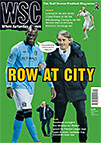 Calls for a trial of new safe standing technology in the top two tiers are slowly starting to gather political support, Tom Hocking writes
Calls for a trial of new safe standing technology in the top two tiers are slowly starting to gather political support, Tom Hocking writes
The Safe Standing Roadshow has spent the last year showing fans and officials around the country how standing could work in the England’s top two divisions. On December 11, 2012 it arrived in Parliament. The event, held in conjunction with the Football Supporters’ Federation (FSF) and sponsored by Roger Godsiff MP, took the case for safe standing to the Attlee Suite of Portcullis House, across the road from Big Ben.
Calls for more discussions at a higher-level about safe standing have been growing for years, with various surveys of fans showing an increasing level of support for them to be given a choice between sitting and standing when they attend matches. This led to Godsiff, Labour MP for Birmingham Hall Green, putting forward an Early Day Motion in October for the House to consider a pilot scheme of new standing technology in football stadiums. So far it has been signed by 63 MPs and December’s event signified the next stage in building political support for the campaign.
The aim, according to roadshow organiser John Darch, was to “present a solution that the decision-makers will be able to accept”. A panel of experts, including Peterborough United CEO Bob Symns and Superintendent Steven Graham of West Midlands Police, lent weight and a variety of perspectives to the occasion.
The proposed solution is the introduction of “rail seats”. Currently widely used in Germany, they are bolted on in place of existing seats and adhere to UEFA and FIFA standards, yet can be locked in the upright position by groundsmen to allow standing. At the end of December Sunderland began suspending the season tickets of fans for persistent standing at their ground. The club said they had received an “increasing number of complaints” from supporters wishing to sit whose experience was being spoilt by people standing around them.
Introducing areas of rail seating would give those fans wishing to stand a place to do so, without affecting the enjoyment of those who want to sit in the majority of the stadium. The dangers of falling forwards over low-backed seats and risks of crowd surging in rail-seated standing areas would be eliminated by safety barriers every two rows. There is no call for a “return” to old-style terracing; for now the FSF only wish to trial the new technology. Aston Villa have indicated they would be willing to participate, while Peterborough United – who will need to replace their current terracing with seats if they remain in the Championship this season – are also eager. Another 15 clubs have openly supported the campaign, including Swansea in the Premier League.
Graham’s presence on the panel at the Parliamentary event was significant. With over 20 years of experience and as the operational lead for policing football in the West Midlands, he said there has been “a mood change within police match commanders” because the game, stewarding, policing and supporters have changed since terracing was outlawed. He continued: “I would like to think my chief constable would not oppose a move to safe standing. The idea that if people are put in a standing area they will behave criminally is totally wrong.
“We have experience of standing at English football in the 1980s and of German standing areas now but very little experience of what standing would look like in the UK now. We need to gather data so we can make decisions and give the best customer experience. I would not be riddled with fear if I was policing a standing area.”
That so many important figures are now willing to discuss the previously taboo topic is credit to the work of the FSF and the Safe Standing Roadshow in presenting a workable alternative to all-seat stadiums, yet concerns remain. Reacting to the event Margaret Aspinall, chair of the Hillsborough Family Support Group, said: “There are 96 reasons why it should not be allowed. Standing should never, ever come back. I do not think there is anything safe about standing.” The words “standing” and “football” immediately and understandably conjure chilling images in England but this is new technology for a new era.
Such is the sensitivity of this issue there is no point the FSF trying to force a decision. All they can do is continue the educational process and present the alternative until enough people realise there is another way to watch football; a way that is just as safe and caters for everyone.
From WSC 312 February 2013